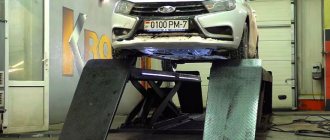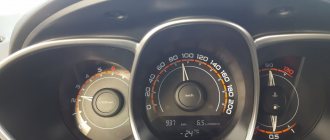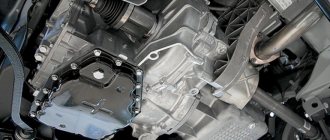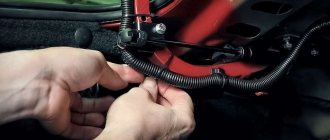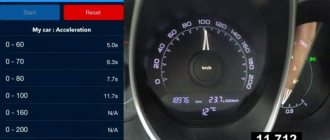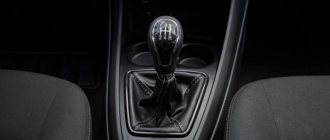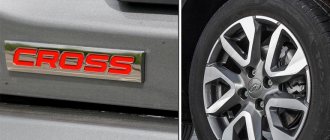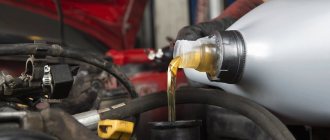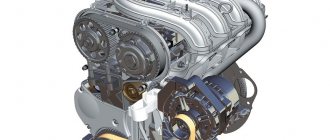Two years ago, a new product from the domestic AvtoVAZ, the Lada Vesta with a robotic gearbox, went on sale. The engineers abandoned the classic torque converter (Jatco JF414E) due to its high cost and lack of a production platform for maintenance.
AMT - this is how “robot” is designated; it was developed by the domestic design bureau of AvtoVAZ based on the mechanical type of ZF class gearbox. Of course, in terms of gear shift speed, AMT is inferior to foreign analogues from Europe and America, but it looks quite decent on the Russian market.
LADA Vesta is equipped with AMT paired with a 1.6-liter / 106-horsepower and 1.8-liter / 122-horsepower power unit. The price per copy varies from 640,000 to 850,000 rubles. AMT is also installed on Vesta SW and LADA Vesta Cross with an engine capacity of 1.8 liters. Starting price from 705,000 rubles.
New technologies in domestic production
Buyers choosing a new car look thoughtfully at the new AMT from Lada. What is it, what is its operating principle? In fact, this is a regular manual transmission, only it does not have a clutch pedal. Instead of three levers, you only get two - gas and brake. The compact gearbox has off, on and shift modes, which replace the familiar pedal.
Reviews of the Lada Vesta robot show that not everyone liked the manufacturer’s innovations. The automated gearbox is developed on the basis of the manual transmission of VAZ cars. The control system uses the latest ZF developments, which help to change gears faster. In terms of quality, the new AMT is clearly better than the old technologies on the Lada Kalina, but at the same time inferior to European analogues (BMW, Ford, etc.). What positions are there on the shift lever in the new Lada Vesta?
- Auto mode – allows you not to think about changing gears at all.
- Neutral position is acceptable when the car is parked.
- Reverse – in this position, as you might guess, the car will go backwards.
- Manual shift - allows you to change gears yourself if you want to overtake someone or save fuel. If you want to downshift, then you don’t have to touch the lever at all - the Lada itself will do everything for you if you take your foot off the gas pedal.
Gearbox robot
The Lada Vesta car uses a robot as an automatic transmission. It is really difficult to say why the engineers of the automobile concern chose this particular option, because there are now a large number of torque converters from various manufacturers on the market.
The concern's designers took the VAZ gearbox as the basis for the AMT (robot), in contrast to the mechanical transmission of this model, which uses a unit from Renault. In general, this is a conventional mechanics on which an electronic control unit has been installed. The use of this box is determined more by price than by other factors. The AMT gear lever does not have a parking position, only reverse gear, neutral gear, automatic mode (something like drive) and manual shifting. The interesting thing is that when changing gears manually, you cannot engage reverse or go into neutral. Forward gears are used.
What is the difference between AMT and automatic transmission?
How does the robot on the Vesta work and how does it differ from a car with an automatic transmission? In terms of structure, it is designed exactly the same as a manual transmission. A robotic one has little in common with an automatic transmission. If in a conventional automatic transmission the torque is transmitted from the engine to the wheels by a torque converter, then in a robotic gearbox the torque is transmitted through gears. The robot was made on the basis of a VAZ mechanical transmission. The AMT consists of the mechanical box itself, the clutch and the electronic unit that controls it.
When developing the new box, engineers from the Tolyatti plant used the experience of foreign manufacturers. And the clutch included in the AMT package is made in France. The part is protected by a wear compensation function that prevents premature failure. There have not yet been any cases of warranty claim registered.
Many people are perplexed: why can’t an automatic transmission be developed on a Russian basis, because so far no domestic car has such an improvement. The answer is simple: the development of automatic transmissions is possible already on the existing base, which does not yet exist in Russia. And production based on foreign developments will significantly increase the final cost of the car. For comparison, using an automatic machine will cost approximately twice as much as a robot.
Instructions for using a machine with AMT
How to use the new gearbox? Reviews from owners of the Lada Vesta 1.8 robot indicate that you still need to learn how to use the AMT. The car's on-board computer displays information that helps monitor the operation of the transmission:
- Mode (manual/automatic).
- Active transmission.
- Brake pedal activity.
So how do you start a Lada Vesta with AMT? To do this you need to follow a number of simple steps:
- Press the brake pedal.
- Move the shift lever to the neutral position.
- Start the car.
It is important to note that any changes in the position of the selector can only be made while the brake pedal is pressed. If you want to park the car, the manufacturer recommends turning off the engine, leaving the handle in the manual or automatic mode position. Very often, novice drivers have a question: what to do if you get stuck in a traffic jam on a slope? To prevent the car from rolling back, it is permissible to lightly press the gas pedal. When driving on a slope, the robot selects first or second gear so that the engine does not stall.
Another useful feature of LADA with AMT is that it can be started from a pusher. Rope launch is activated at speeds of 7 km/h and above. The car also has a transmission brake function. When rolling down an inclined surface, it is permissible to use the brake pedal for more effective braking. All these useful modes make operating the Lada Vesta with AMT convenient and comfortable.
Test drive by specialists
What do professionals say about the robot box in Lada Vesta? You can find many reviews of the new product on the Internet. Most note the slow response of the box during acceleration. Some call the driving style of the Lada Vesta robot a style for summer residents. Slow acceleration of the car contributes not only to fuel economy, but also to passive safety. No matter how hard you try to squeeze out maximum speed in order to overtake three or two cars, it is unlikely that you will be able to do it quickly. True, the car behaves a little more cheerfully in manual mode, in which it is more realistic to squeeze the maximum out of the 1.8-liter engine. But, if you get used to this driving style, you begin to notice the advantages: the parts are made well and do not fail for a long time. Compared to manual and automatic transmissions, AMT provides significant fuel savings.
After the driver presses on the gas and the engine picks up speed, the transmission begins to upshift. The problem is that the robot on the Vesta cannot do this without reducing the thrust. The switching time fluctuates around 2 seconds, which can be quite annoying at first. But you won’t feel any jerks, the clutch is as smooth and comfortable as possible. In the reviews of the owners of the Lada Vesta robot in 2022, you can find a comic name for this driving style - driving a Chinese dummy. Due to the excessively sharp speed difference between first and second gear, Vesta drivers and passengers nod due to uneven acceleration.
But, despite various points of view, most reviews about the Vesta 1.8 robot indicate that the introduction of an automated manual transmission was a big leap forward for the domestic manufacturer. Car enthusiasts hope that the improvements will not end there; Lada engineers will properly finalize the box, and it will be a pleasure to drive. By the way, on the official website of the automaker there is already a survey on what users would like to change in the AMT box. So you should be patient - improvements are just around the corner.
Technical characteristics of Lada Vesta modifications
| Name | 1.6 l 16-cl. (106 hp) 5MT 1.6 l 16-cl. (106 hp) 5AMT | 1.8 l 16 cl. (122 hp) 5MT | 1.8 l 16 cl. (122 hp) 5AMT |
| Wheel formula | 4 / 2 | ||
| Motor location | Front | ||
| Body type / number of seats / doors | Sedan / 5 / 4 | ||
| Base | 2635 | ||
| DSHV | 4410 / 1764 / 1497 | ||
| Clearance | 178 | ||
| Trunk volume | 480 | ||
| Power unit | 21129 | ||
| Supply system | Injection | ||
| Number of cylinders / arrangement | 4 / in-line | ||
| Volume | 1596 | 1774 | 1596 |
| Power | 106 | 122 | 106 |
| Maximum speed | 182 | 186 | 182 |
| Acceleration up to 100 km/h | 11,2 | 12,1 | 14,1 |
| Fuel consumption (G/T/SM) | 9,3 / 5,5 / 6,9 | 9,3 / 6,0 / 7,2 | 9,0 / 5,3 / 6,6 |
| Weight | 1230 | ||
| Volume of the tank | 55 | ||
| Number of gears | 5 | ||
Robot on Vesta: reviews
Drivers online are furiously discussing Lada's innovation. Both experienced drivers and beginners who have previously driven only a manual transmission become participants in the debate. Reviews from owners of a Lada Vesta with a robot indicate that not everyone has an unambiguous perception of this new product. On the one hand, there are no those who are 100% satisfied with the AMT of the domestic manufacturer. On the other hand, is it worth being so critical of the first attempts to automate machine control?
Let's take a closer look. The main thing when buying a Lada Vesta with AMT is to clearly understand who such a car is intended for. First of all, this is a car for a quiet and comfortable ride around the city, and not for racing. Vesta with a robotic gearbox is ideal for city traffic jams. If you are tired of manual gear shifting, but foreign cars with an automatic transmission are not yet available to you, then the new Lada will be an excellent option.
Reviews about the Lada Vesta 1.8 robot show that automatic transmission lovers should not buy a car with AMT. Still, these are two completely different boxes that have little in common with each other. Fast automated transmissions of such giants as BMW or Porsche cannot be compared with the Lada gearbox. They change gears quickly and smoothly, without delay. The robot on the Lada Vesta is more like the AMT of old Japanese cars. Nevertheless, this is an excellent compromise option for those who are tired of riding with mechanics.
Doesn't break anymore
I know firsthand how both options behave. I tested the CVT Vesta in the Caucasus and drove it in Moscow. And I’ve been living side by side with the robotic Vesta for 4.5 years now and have driven more than 90,000 km.
Life together with the robot did not work out right away. It is the driver who must adapt to it, and not vice versa! So, if you are looking closely at the “automated” Vesta of the first years of production (on the secondary market), keep in mind: you need to be a very calm driver with nerves of steel so that the box does not irritate you.
After about a year and a half in Tolyatti, the problem of the rapid death of the clutch was corrected. It turned out to be so gentle that even slow shifts did not help. On my car, the clutch kits lasted 20,000 and 18,000 km, and for some, the first signs of wear appeared after 5000–7000 km!
Now the third, reinforced clutch is coming to an end on the editorial car. You'll be lucky if it lasts 60,000 km (that is, up to 98,000 on the odometer). In general, you need to be prepared for quick repairs - and when buying a used Vesta, I would consider the original factory kit as a minus. Especially if it is an old model.
The Renault-Nissan 1.6 engine (113 hp) lacks a decorative cover. Let be! On a VAZ engine it is attached to flimsy pegs that are prone to getting lost. It does not protect from dirt outside and from engine noise - only decoration.
The Renault-Nissan 1.6 engine (113 hp) lacks a decorative cover. Let be! On a VAZ engine it is attached to flimsy pegs that are prone to getting lost. It does not protect from dirt outside and from engine noise - only decoration.
Interestingly, the clutches of the first and second versions signal wear differently. The old clutch begins to respond with shocks in traffic jams, and the car shakes in convulsions at the beginning of movement. The modernized one behaves intelligently, reminding of wear with exceptionally soft slipping, clearly visible in the timbre of the engine and tachometer readings. Therefore, now I will drive all the way, but I changed the previous sets preventively: I did not have the strength to endure their hysterics.
The nuances of driving the Vesta robot
As with all cars, when driving a Lada robot, there are some nuances that should be taken into account when purchasing. They can be understood most clearly if you read the reviews about the robot on Vesta. For example, the gearbox is sometimes tricky when changing gears. If you are driving in second gear, slowly picking up speed, the robot may misunderstand you and shift to first gear instead of third. This often happens during not very dynamic acceleration.
If you need a faster start, there is a little trick. Usually, when driving on the highway, the robot engages fifth gear. If you press the gas pedal to the floor, the car engages third gear, after which the speed immediately increases. This allows you to overtake on high-speed sections of the road. After completing the maneuver, just release the pedal to its normal state, and the AMT will switch back to 5th gear.
As we have already said, a processor is inserted into the robot on the Lada, which reads the behavior and driving style of the driver and adapts to it. If you want the most dynamic acceleration without jerking, then you can try the following driving style:
- Accelerate without releasing the gas pedal. The robot itself will select the right moment to shift from first gear to second, and then to third. But be prepared for a slight jerk between shifts.
- Once your car reaches a speed of 40 km/h, release the gas pedal slightly. At this moment, the car will smoothly shift gears.
- The same action must be repeated at a speed of about 60-80 if you are going to go even faster.
- If at speed 4 you do not press the gas pedal to the floor, then, most likely, AMT will immediately set speed 5, at which dynamic acceleration is impossible.
- When driving uphill, the robot itself slows down if it becomes difficult for the engine to hold the current gear. For beginners, this nuance is especially good: now your car will definitely not stall while climbing a slope.
You still need to get used to driving a manual automatic transmission, but the convenience and reasonable cost of the AMT completely hides all its shortcomings.
What configuration does the AMT come with?
Lada Vesta with an automated manual transmission is available only in luxury configuration. When purchasing this assembly, you can also purchase a manual transmission, which is standard. But for the robot you will have to pay about 25,000 rubles.
Considering that the price for a Lada Vesta in the maximum configuration exceeds 600 thousand, a reasonable question arises: is the game worth the candle? What advantages and disadvantages can be found in such a supplement?
Almost two years ago, at the Lada Vesta Night in Krasnoyarsk, we (Drom.ru) were one of the first in Russia to incognito buy a black Lada Vesta with a 1.6-liter 106-horsepower engine, an automated transmission (AMT) and maximum configuration Luxe Multimedia. Exactly 23 months have passed, Vesta has traveled 78,882 km (of which approximately 42 thousand were driven by the author of these lines), it’s time to take stock. So - “Take or run?”
The “black” Lada Vesta will follow the path of other dromomobiles - on Friday, November 3, it will be sold at auction . Starting price - 1 rub. See the lot page
Our Vesta was used in different climatic zones and on roads with a wide variety of surfaces
Arguments for"
Price
I personally know two people who bought Vesta only because they did not see any other alternative on the market. The logic was something like this: “There are 600 thousand rubles available. There are no other new full-fledged cars at this price. There were no decent offers on the secondary market (and primarily among right-hand drive cars) for this amount, at least in Irkutsk. So I chose Vesta. And I haven’t regretted it yet.”
Immediately after the purchase, we sent Vesta out for test drives by Droma readers in the cities of the Urals, Siberia and the Far East.
When we bought Vesta two years ago, we paid 670 thousand rubles for the top version of Luxe Multimedia (including additional payment for color). For this money then you could buy a Hyundai Solaris, Kia Rio, Renault Logan, Volkswagen Polo or Nissan Almera in a comparable configuration. And even with such competition, at the start of sales there was a rush demand for Vesta.
Since then the situation has changed. Today, “our” Lada Vesta 1.6 (106 hp) 5-AMT Luxe Multimedia, including the surcharge for metallic paint, costs RUB 731,000. The price increase over two years is 61,000 rubles. But competitors, due to the larger import component and the rise in the dollar/euro exchange rate, have risen in price more significantly. When preparing the material, we calculated the cost of competitors on dealers’ websites (cars in the B+ segment, which are included in the Top 25 sales for the first 9 months of 2022) with a 1.6-liter engine and automatic transmission in the closest trim levels.
| brand, model | Units sold* | Cost, rub. | Competitive advantages |
| Kia Rio | 73 532 | 909 900 | 123 hp, 6-automatic transmission |
| Lada Vesta | 54 641 | 741 000 | Cruise control, navigation, rear view camera, anti-theft system, EBD, ESC, TCS |
| Hyundai Solaris | 53 264 | 964 900 | 123 hp, 6-automatic transmission |
| Volkswagen Polo | 33 999 | 940 850 | 6-automatic transmission, cruise control |
| Skoda Rapid | 21 605 | 1 032 062 | 6-automatic transmission, cruise control |
| *Based on sales in Russia in January-September 2022. |
What do we end up with? Lada Vesta is more affordable than all competitors by at least almost 100 thousand rubles. When purchasing a Kia Rio there is now a discount of up to RUB 75,000. for recycling an old car with a loan for a new one. Without it, the price of the model is approaching Polo and Solaris. In addition to the price, Vesta has the best equipment among its competitors. The downside is the low-power engine (with a 122-horsepower 1.8-liter engine, Vesta will cost 756,900 rubles in the top) and the controversial robotic transmission.
I would consider the option with a 1.8-liter engine (at the time of our purchase there was no such version). The available 1.6-liter engine is quite sufficient for city driving, but it reacts painfully when fully loaded and is not enough for dynamic overtaking on the highway. But AvtoVAZ does not offer a full-fledged automatic transmission for Vesta in principle. The existing “robot” makes the car more expensive compared to a “mechanical” one by 25,000 rubles. (at Rio you will have to pay 40 thousand extra for a 6-speed automatic transmission) and is quite economical.
Maintenance and repair: price and availability
The final maintenance and repair of Vesta took place in the Yablonovsky car (Adygea)
For residents of the outback, it is important that AvtoVAZ has the widest dealer network in Russia, unlike its competitors, it is almost always (with the exception of Eastern Siberia and the Far East) “within walking distance.” Personal experience of owning a Vesta suggests that you can sign up for maintenance (Irkutsk, Krasnodar) literally the next day (although my colleague Ksenia Frolova had problems signing up for Vesta maintenance in Krasnoyarsk, and in Vladivostok, waiting for trivial spare parts, the car sat within warranty repair 45 days). VAZ dealership centers today are not inferior to “foreign-brand” service stations in terms of customer focus and comfort. Nevertheless, both in Irkutsk (TO-60) and Krasnodar (TO-75) they could not eliminate the shaking at the start, and the burning “check” has been following us for 20 thousand km - AvtoVAZ has yet to extinguish this “guiding star” not possible.
In addition to the lit “check”, the transmission fault indicator flashes periodically (for example, after slipping)
Various studies indicate that AvtoVAZ models are today the most inexpensive in terms of maintenance. Let's look at the cost of maintenance - declared by the manufacturer and real - taking into account additional and unscheduled repairs.
| Mileage, km | Declared price, rub. | Actual price, rub. | Cost of additional work (RUB) |
| 8445 | — | 1040 | Oil change at the request of the dealer |
| 14 386 | 5500 | 3398 | |
| 15 964 | — | 1600 | Oil change after a breakdown in the north of Baikal; engine plug - 400 |
| 30 059 | 7600 | 7800 | |
| 44 836 | 5500 | 9650 | Replacement of front brake pads - 3000 |
| 50 900 | — | 8500 | Replacing two light bulbs - 1100, replacing rear wheel bearings - 7400 |
| 59 344 | 7600 | 5652 | |
| 63 705 | — | 1720 | Replacing front brake discs |
| 75 034 | 5500 | 22 875 | Repair of radiator mounting, replacement of generator drive belt - 6168, replacement of front shock absorbers - 11,244 |
In total, 62,635 rubles were spent on maintenance and repairs for almost 80,000 km. A lot of? Not enough, especially considering that a quarter of this amount was spent on maintenance, or rather, recent repairs in Krasnodar. After a fairly gentle collision with the curb of the parking rows (out of sight), the radiator mount broke and the generator drive belt was damaged. This only became clear during scheduled and unscheduled maintenance; at first it did not indicate anything about malfunctions.
As a result of a collision with a curb stone, the parking row fencing bent the engine protection and broke off the radiator mount. The bent front suspension arm apparently began to come into contact with the alternator drive belt, which ultimately led to its breakage
A couple of weeks after hitting the curb, this led to the most serious (!) incident with the car, in fact, the only emergency situation. First, the air conditioner stopped “freezing”, then the warning light flashed about a malfunction in the power supply system. Intuitively, we managed to jump out of one of the 10-point traffic jams that shackled Krasnodar (due to a special operation to catch criminals who shot at police), and on the side of the road the car had already completely “died” from a complete blackout.
Vesta and his friend were only able to be resuscitated in the evening. The first diagnosis (which ultimately turned out to be wrong): in total traffic jams and extreme heat, the liquid in the battery boiled away. We bought and installed a new battery, which seemed to solve the problem.
But a 40-minute stand in a traffic jam when returning home led to a repetition of the problem: the power supply fault lamp flashed again. I signed up for service (at the Lada service station in Yablonovsky, Adygea) immediately (especially since the time for the next maintenance had come) and went early in the morning so as not to “die” again in a traffic jam. I was literally a kilometer short of getting to the service (the new battery was depleted without recharging) - I had to ask for “help from a friend” again. At the station they were very surprised that when the generator drive belt broke (and this was precisely the cause of the malfunction), the car arrived under its own power.
Maintenance and troubleshooting took 7 hours. We had to stop by again for a couple of hours to replace the front shock absorbers, which were not immediately in stock (the cost including labor and additional installation of the front shock absorber boot was RUB 11,244). Not cheap! But the alternative service failed to replace the shock absorbers: the largest suspension service chain in Russia refused to do this simple operation, citing the fact that AvtoVAZ classified data on the nomenclature of the struts. So now everything about the new Vesta is grown-up: in the garage you can only change a light bulb.
About other breakdowns at the distance
Vesta did not cause any problems with breakdowns and did not require constant close attention. Here is a complete list of faults.
• After driving in 40-degree frost, excess gas pressure squeezed out the technological plug on the side wall of the engine block head, which led to a critical loss of engine oil. The malfunction was diagnosed and repairs were carried out in the field (taiga in the north of Lake Baikal). Subsequently, the company service center changed the oil and installed a new plug (1,600 rubles).
• Breakage of two bolts securing the right engine mount. This case became the most problematic, since the car sat at the VAZ branded service station in Vladivostok for 45 days awaiting repairs!
• Replacement (under warranty) of the front stabilizer bar mounting bracket.
Yes, that's all, nothing critical!
At the YugMotorShow 2017 Tuning Festival, Vesta idled for three days, saving the organizing team from heat stroke (plus 36°C) with its always cool interior, while the outside temperature indicator on the instrument panel gave some unreal values
Fuel efficiency
On the highway we consumed 5.5-7.0 liters/100 km, drove 800-1000 km at one gas station, in normal city mode fuel consumption fluctuates around 10 liters. Average consumption over the entire period of operation is 8.74 l/100 km (the manual version is 8.30 l/100 km).
Consumer qualities with a plus sign:
— low operating costs (maintenance, compulsory motor insurance); — the most spacious interior and trunk in the class (confirmed by expert opinions);
— energy-intensive suspension; — good visibility; — high (best in class) ground clearance, tolerant of full load;
From time to time we used Vesta in places where a crossover would be much more appropriate
— reliable engine starting in cold temperatures down to -35°C (this has been proven more than once in practice); — effective air conditioning (with a temperature constant of 36 degrees in Krasnodar, this is perhaps the main characteristic of comfort); — multimedia with good navigation and rear view camera.
Arguments against"
Consumer qualities with a minus sign:
— unstable build quality of the model as a whole, which is confirmed both by the experience of owning our other Lada Vesta, and by numerous reviews about the operation of the car on Drom.ru; — the worst speed and dynamic qualities in the class; — dependence of the dynamics on the degree of vehicle loading. At full load - 4 passengers and luggage, as happened with our team when moving to work on organizing the Siberia Motor Show in Krasnoyarsk, Vesta's overtaking abilities dropped significantly; - high noise.
AMT transmission
The robotic transmission still raises many questions among potential consumers, and AvtoVAZ does not offer a regular automatic transmission. “Pseudo-automatic” never found any fans - “mechanics” account for 85% of sales. The algorithm (“hanging” in lower gears) requires getting used to, and we were never able to get rid of the periodic shaking when starting off, despite our constant complaints at the VAZ service center.
So - “Fight or Run”?
There’s definitely no point in running away - AvtoVAZ has produced a completely modern, competitive, inexpensive, and, as our experience shows, relatively high-quality car. In terms of price/quality/set of options, in my opinion, it is the best in its segment. But precisely with this distribution of emphasis - if you put price first.
Efim Nezvanny, photo by the author
The “black” Lada Vesta will follow the path of other dromomobiles - on Friday,
November 3, it will be sold at auction . Starting price - 1 rub. See the lot page
Photo bonus. The Adventures of Lada Vesta
Abkhazia
Dombay
Elbrus
Advantages and disadvantages of the robot on Vesta
Let's start with the advantages. According to reviews of the robot on Vesta, the machine has the following undeniable advantages:
- Equipped with the “Slope Start Assistant” program – even if you park or get stuck in a traffic jam on a slope, this option will help you avoid rolling back when starting. The gearbox increases speed at the start, the clutch becomes stiffer.
- Increased clutch life - thanks to the soft and smooth operation of the AMT, the service life of the part will be long even with careless driving. The shift box is protected against accidental pressing of the lever: if you start shifting it chaotically, the car simply will not react.
- AMT is adaptive and has 26 behavior patterns that it selects depending on the driver’s behavior. How it works? The program reads how the driver operates the gas pedal and, depending on this, switches the clutch at the right moment.
- Fuel economy is hard to believe, but the robot on the Lada is really more economical than a manual or automatic transmission. Thanks to smooth switching, you can use several times less gasoline.
- AMT consumes less oil than manual transmission - also a significant factor in favor of choosing a new configuration.
Reviews of the robot box on Vesta also show the disadvantages of an automated manual box:
- The absence of a parking mode makes parking more difficult; when parking, it is better to leave the control lever in manual or automatic mode to avoid rolling back.
- Gear changes are jerky - between 1st and 2nd gears there is a decrease in speed, which can noticeably slow down the car.
- Slow acceleration - a car with AMT takes a few seconds longer to pick up speed than a car with a manual transmission.
- The inconvenience of the manual mode is that the gearbox is not designed very well, and this makes manual driving of the car less convenient.
Possible problems with the robot and the advantages of the box.
The negative attitude of most people towards the AMT transmission is very justified, because many automakers who have used a robotic gearbox in their models can receive a whole list of complaints from car owners. This includes jerking at the most inopportune moment, howling of the transmission with subsequent breakdown and a call to the service center. Transmission manufacturers such as Opel, Ford, Toyota and Honda have tarnished their reputation. European models were slightly better, and the most negative reviews about the robot gearbox were received by the Japanese.
At the same time, with a quiet ride, proper maintenance and adaptation of the AMT to your driving style, the cars were possible to use. At the gearbox of the Lada Vesta robot, a ZF control unit is used, which is well known when using manual transmission automation. At the same time, this is not the best option; Opel and Ford also used gearbox blocks from this manufacturer.
Vesta comes with a robotic gearbox with better and more reliable switching algorithms, due to which the car drives really well.
Pros of a robotic box:
- In order to start moving, you need to move the box to position “A” (automatic mode), thanks to which you avoid overheating of the clutch, unlike, for example, DSG boxes.
- With proper driving and maintenance, the unit will last a very long time, due to a more accurate switching algorithm than a manual gearbox.
- The hard start program and incline assist will help you climb uphill with a loaded car.
- Smooth switching during quiet driving without jerks or joints.
Cons of AMT:
- If you are a fan of active driving, we do not recommend buying a car with a robotic gearbox, since the average gear shift time, as stated by the manufacturer, is about 2 seconds.
- Gear changes during acceleration are accompanied by some pauses.
- If the box is not used correctly, repairs are frequent and not very cheap.
- There are no paddle shifters, instead you have to pull the gearbox lever.
Which is better to choose manual or AMT?
The choice between a manual transmission and AMT should be made with a cool head, having calculated all the pros and cons in advance. On the Internet you can find many good reviews about the mechanics or robot of the Lada Vesta. But most drivers opt for an automated manual transmission. It is much more convenient and economical to use. But lovers of classics and conservatives still prefer the usual mechanics. You can only understand whether a car with AMT is suitable for you or not by trying it in action.
